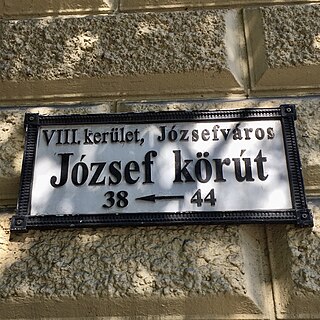
Kerepesi Cemetery is the most famous cemetery in Budapest. It is one of the oldest cemeteries in Hungary, and has been almost completely preserved.

Magyar Testgyakorlók Köre is a multi-sports club from Budapest, founded in 1888. It has sections for football, handball, basketball, volleyball, futsal, ice hockey, water polo, cycling, gymnastics, athletics, fencing, canoeing, boxing, wrestling, swimming, rowing, karate, taekwondo, sailing, speed skating, skiing, table tennis, tennis and chess.

Farkasréti Cemetery or Farkasrét Cemetery is one of the most famous cemeteries in Budapest. It opened in 1894 and is noted for its extensive views of the city.

The Liszt Ferenc Academy of Music is a music university and a concert hall in Budapest, Hungary, founded on November 14, 1875. It is home to the Liszt Collection, which features several valuable books and manuscripts donated by Franz Liszt upon his death, and the AVISO studio, a collaboration between the governments of Hungary and Japan to provide sound recording equipment and training for students. The Liszt Ferenc Academy of Music was founded by Franz Liszt himself.

Ödön Lechner was a Hungarian architect, one of the prime representatives of the Hungarian Szecesszió style, which was related to Art Nouveau in the rest of Europe, including the Vienna Secession. He is famous for decorating his buildings with Zsolnay tile patterns inspired by old Magyar and Turkic folk art, which are combined with modern materials such as iron.
The Hungary national handball team is administered by the Hungarian Handball Federation.

Hungary competed at the 1960 Summer Olympics in Rome, Italy. 184 competitors, 157 men and 27 women, took part in 107 events in 18 sports.
Gábor Preisich was a Hungarian architect. He won the Herder Prize in 1975 along with Romanian poet Nichita Stănescu.

Budapest's Palotanegyed forms an inner part of Pest, the eastern half of Budapest. Known until the communist period as the ‘Magnates’ Quarter’, it consists of the western part of the city's Eighth District, or Józsefváros, which was named on 7 November 1777 after Joseph II, Holy Roman Emperor and Archduke of Austria (1741-1790), who reigned 1765-1790. . Józsefváros developed immediately east of the medieval walls of Pest and was originally called Lerchenfeld or the Alsó-Külváros. The Palotanegyed's borders are the Múzeum körút to the west, Rákóczi út to the north, the József körút to the east and Üllői út to the south. There is an extensive photo archive of the Palace District at the Fortepan website.
Attila út is a road with heavy traffic in the 1st District of Budapest. It runs between Krisztina Boulevard and Elisabeth Bridge. Between the bridge and the Horváth Garden it is a one-way route towards Széll Kálmán Square.
Sándor Boldogfai Farkas was a Hungarian sculptor, medalist.